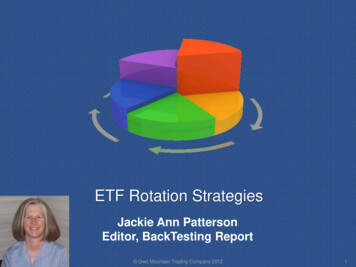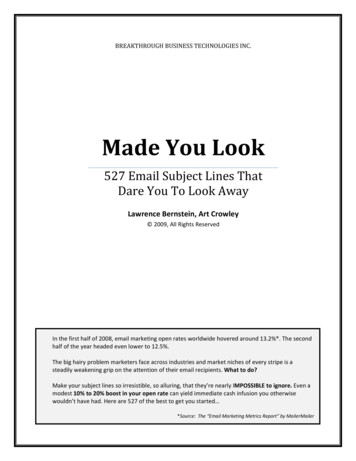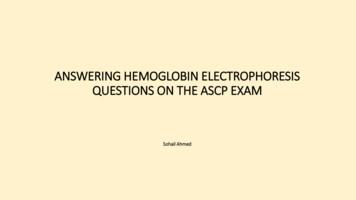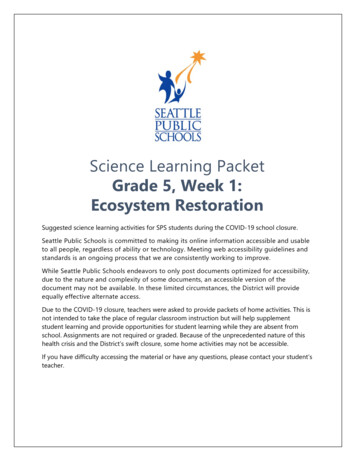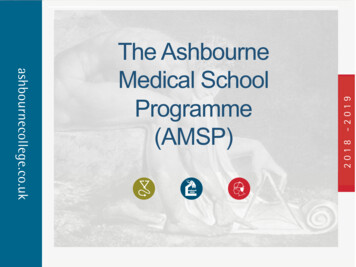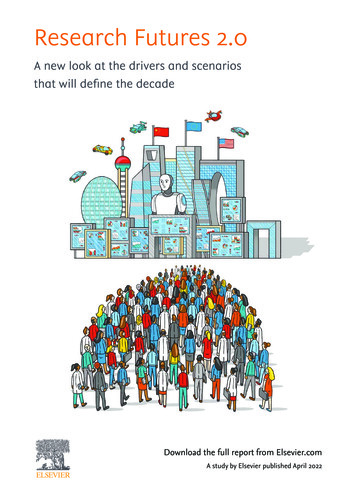
Transcription
Research Futures 2.0A new look at the drivers and scenariosthat will define the decadeDownload the full report from Elsevier.comA study by Elsevier published April 2022
Research Futures 2.0ContentsForeword - Mirit Eldor, EVP of Strategy, Elsevier3Introduction4Summary7Essay one: Funding the future9Essay two: Pathways to open science33Essay three: How researchers work: Change ahead57Essay four: Technology: Revolution or evolution?83Essay five: Building the future research information system103Essay six: The academy and beyond124Methodology145Acknowledgements147Research Futures 2.02
Research Futures 2.0ForewordAt Elsevier, our mission is to help researchers and healthcare professionals to advance scienceand improve health outcomes for the benefit of society. We continuously adapt and evolve howwe support the communities we serve so that we can optimally meet their changing needs, todayand in the future. We do this by bringing together content, data, analytics, and technology.In 2019, we shared our first Research Futures report. This was a large-scale study that examinedthe research landscape to identify what could happen in the decade to come. Notably, we hadidentified three scenarios for the next 10 years: Brave Open World, with increasing share of openscience; Tech Titans, where AI and tech companies play a larger role in the research ecosystem;and Eastern Ascendance, where China’s plays a bigger role in the progression of global research.Three years on, the research ecosystem continues to undergo rapid change, accelerated byCOVID-19. Change is being fueled by many factors, including advances in technology, fundingchallenges and opportunities, political uncertainty, and new pressures on women in research.Our new Research Futures report reflects key findings in these areas, alongside the validationfor our three future scenarios.Our goal is that the insights uncovered in this report will help all of us better prepare for thefuture. Please do contact us with your thoughts and ideas!Mirit EldorExecutive Vice President Strategy, ElsevierResearch Futures 2.03
IntroductionWhat we did in the original studyBack in 2018, with the help of Ipsos MORI, we set out to conduct a study to try to understand how the rapid andprofound changes we were witnessing in science, technology and medicine were impacting the research landscape.Our goal was straightforward: to equip all of us in the industry with the knowledge we needed to navigate theopportunities and challenges that lay ahead. Drawing on a comprehensive literature review, interviews with56 technology, research and publishing experts around the globe, and a survey of 2,055 researchers, we attemptedto build a blueprint for the coming 10 years.In February 2019, we published the report based on that study—Research futures: Drivers and scenarios for the nextdecade. It comprised two key pillars:Pillar one: the six themesNineteen key drivers expected to shape developments in the decade ahead were identified during our discovery phase.We grouped these drivers into six themes and explored each of them in essay form.Funding the futurePathways to open science1. The funding mix is changing;public funders will have lessinfluence over research priorities4. Research grants will increasinglyhave open science conditionsattached2. China is stepping up thefunding and productionof research5. Researchers are expected tospearhead adoption of openscience, but not withoutexperiencing conflicts of interest3. The research agenda ischanging; there is anincreased focus on makingresearch accessibleTechnology: revolutionor evolution?10. Big data is fast becoming thelifeblood of nearly all research11. Artificial intelligence (AI) andmachine-learning tools arechanging the shape of science12. Blockchain has the potential tofacilitate open science, but thetechnology is still in its infancyand may not fulfil its promise6. Metrics will continue to expand,enabled by new technologyBuilding the futureresearch informationsystem14. The role of the journal istransforming to meemodern needs15. The article structure is evolvingand new forms will becomethe norm16. The measurement system willbecome even more criticalHow researchers work:change ahead7. New technologies are expectedto transform the researcherworkflow by the end of the tenyears under review8. Behaviors and skillsets willchange as a new generation ofresearchers arrives on the scene9. Collaboration will driveresearch forwardThe academy and beyond17. Courses will diversify froma lecture-focused model18. Higher education institutionsare changing structure19. EdTech will become a serioushigher education contender13. Augmented reality (AR) andvirtual reality (VR) will becomekey learning tools for a numberof institutesResearch Futures 2.04
Pillar two: the three scenariosWe held three one-day workshops with internal and external experts. Attendees thought about how the 19 key driversmight influence research and came up with three credible scenarios, each envisaging what the future might look likea decade later.Brave open worldTech titansEastern ascendanceGlobally, state funders andphilanthropic organizationsalign in their goals, approachesand principles, resulting in openscience taking off, especially inEurope, aided by advances inartificial intelligence-enabledtechnologies. Platforms areinteroperable and contentis easy to access.Significant advances in artificialintelligence (AI) products driveinnovation, enabling technologycompanies to support the researchecosystem and become knowledgecreators and curators in a worldwhere industry and philanthropicfoundations are the keyresearch funders.China’s growing economicpower and focus on research anddevelopment (R&D) influencesthe previously Western-dominatedresearch landscape, resultingin a fragmented world.Signposts: Events that wehad thought might indicatethis world is emerging State and philanthropicorganizations unite todevelop programs to containa flu pandemicOne-third of research articlespublished gold open accessin EuropeThree-quarters of researcharticles published greenopen access in the US,China and IndiaSignposts: Events that wehad thought might indicatethis world is emergingSignposts: Events that wehad thought might indicatethis world is emerging Disruption in the EU leads toa recession and a reduction inpublic R&D spend China continues to invest morein R&D; the East/West fundinggap widens Major tech players become asignificant source of publishedresearch As a result of AI-enabledresearch in personalizedmedicine, survival rates forpancreatic cancer increasesubstantially.Europe and the US becomemore protective of resourcesand commercial applications oftheir research; the number ofEast/West partnerships falls Chinese institutes start todominate the global universityranking lists.Repositories consolidate intoone platform, improving accessto articles, data, code, etc.Research Futures 2.05
Fast forward to todayWhat did we find?Since early 2020, the pandemic has transformed everyaspect of researchers’ work. We felt the time was ripe torevisit our first report and consider how the themes andscenarios we identified two years earlier were playingout, particularly in light of COVID-19.The results of our surveys and research are containedin the six essays on pages 9 to 144, which follow thethemes outlined on the previous pages and the formatof the essays in our original report. Our major findingscan be found in the Summary on page 7.During 2020 and 2021, we conducted two separateresearcher surveys asking questions on a broad rangeof topics, from collaboration to education and fromopen science to public engagement. We reviewed theworld of research through the changes of the past twoyears. We also asked researchers to help us understandthe impact of the pandemic on their work. In total,1,066 researchers in 2020 and 1,173 in 2021 from amultitude of disciplines and locations responded to oursurveys. We compared the data collected from thesesurveys with a survey completed in 2018 as part of theoriginal Research Futures study when 2,055 researchersresponded to our survey. You can find out more in theMethodology section on page 145. We also examinedthe latest macro indicators (including R&D expenditure).Looking at the three scenarios identified in our 2019report, we see that elements of each is coming true. Wehave flagged these elements in the essays – look outfor the “scenario match” boxes. That only some aspectsare materializing is not surprising: as we noted in theoriginal report, no single scenario has to be correct;aspects of just one could become reality or they mightcombine in any variety of ways.We have also flagged progress on the drivers of changeidentified in our original study that allowed us toformulate the scenarios. We used a traffic light systemto convey whether or not we feel a driver is evolving inthe way we anticipated: red for no progress, amber forsome progress, and green for clear signs of progression.Importantly, this latest study has confirmed one of thekey findings of our original report, which is that weare at a tipping point and the shifts to come would betransformative. If we are to ensure that this changeis sustainable, action will be needed in unison acrossall the areas we’ve examined. This study underlinesthat all of us who work in the world of research shareresponsibility for creating a new environment in whichresearch can flourish. None of us can do it alone,particularly now.Research Futures 2.06
Research Futures 2.0 – SummarySince our inaugural report in 2019, COVID-19 has hada dramatic impact in every area of science, and indeed,the world. Driven by governments seeking the bestways to safeguard the health of their populations whilekeeping their economies open, or as open as possible,researchers have been at the forefront of each twistand turn of the pandemic as it moved from continentto continent, evolved from one variant to another andanother, and took center stage in contentious decisionsabout everything from freedom of movement, to accessto vaccinations, to widescale lockdowns.Since our last report, researchers and science have beenunder enormous pressure to find solutions to free theworld from COVID-19. Researchers have stepped upto the challenge, developing vaccines in record time,working under extreme time pressure, across bordersand specialties, often in extremely difficult conditions.A challenging funding landscape but withhope on the horizonThe spotlight on science and research has highlightedthe importance of securing adequate funding, a majorconcern for researchers. 50 percent now say thatfunding in their field is insufficient, while just one infour (24 percent) believe funding is adequate, a dropfrom the 30 percent who said that was the case in 2020.Researchers cite fewer funding sources, increasedcompetition, changing priorities and the diversion offunds to COVID-19 related fields as the reasons behindthis trend. However, 39 percent do express optimismthat funding will increase in the next two to three years,rising from 31 percent a year ago. This sentiment maywell have been impacted by stimulus packages initiatedin different parts of the world. It is also likely that closerlinks between the corporate world and science will bringfurther opportunities for researchers in the years ahead,with 41 percent of researchers expecting that corporatefunding of research will increase.Research Futures 2.0Getting the balance rightAs universities closed their campuses and laboratorieswere shuttered, researchers have had to adapt tothe new ways of working imposed by the pandemic,meaning much research has been conducted fromhome. For some, this has enabled a more flexible andproductive working pattern. For others, particularlyfemale researchers, the constant proximity to careresponsibilities has made devoting time to researchmore difficult. Sixty two percent of women indicatedthey had difficulty ensuring a positive work-life balanceduring the pandemic, compared to 50 percent formen. However, that did not seem to diminish women’sexpectation of what can be achieved - 53% of womenscientists think the use of technology in research willaccelerate over the next two to five years in comparisonto 46% of men.Greater collaborationWhether or not researchers have found the move toworking from home welcome, most researchers (63percent) have been collaborating more than in the past,up from 48 percent before the pandemic. Researchershave been working across disciplines more oftenthan before the pandemic, reading preprints to stayconnected to new ideas and increasingly using newtechnology such as AI to help analyze the data sourcesavailable to them.Faster and more open knowledgein publishingThe pandemic has undoubtedly accelerated theadoption of open science. The expansion of preprintshas been one of the notable hallmarks of the pandemicfor researchers who wished to disseminate knowledgequickly and openly. About two-thirds of researchers(67 percent) now consider preprints a valuable sourceof communication, increased from 43 percent beforethe onset of the pandemic, a shift driven in part by theincreased role of preprints in finding ways to tackleCOVID-19. Researchers appreciate the potential ofpreprints to quickly disseminate research findingsand widen their impact. At the same time, however,the potential risks of publishing without peer reviewremains a very strong concern for many in the scientificcommunity and beyond.7
Alongside the expansion of preprints, we also sawan increase in data sharing; over half (52 percent) ofresearchers say they are sharing more research datathan was the case just two to three years ago. We alsosaw the intention to publish an Open Access articleincrease from 49% pre-pandemic in 2019 to 54% a yearlater. Moreover, nearly half of researchers in 2021 (47percent) expected the drive for Open Science to increaseover the next 2 to 5 years.Making an impactAnother aspect of increasing openness is greaterengagement with the public, over the course of thepandemic researchers believe that public engagementwith research has increased - 64% now believe thatpublic understanding of their research is good, up 4percentage points on the prior year. At the same time,researchers recognize they will need to demonstrateimpact - 54 percent anticipate there will be a greateremphasis on the societal impact of research goingforward. This expectation is higher among women(62 percent) than men (52 percent).Embracing new technologyNew technologies have moved out of the laboratoryand into research. AI has been embraced more thanever during the past two years, though some cautionremains. 16% of researchers are extensive users of AIin their research, and while high take-up in ComputerSciences does inflate that number (64% of computerscientists are heavy users), there has been growth inusage of AI in research across most specialties.Getting mobileResearchers have also been reconsidering theirmotivations and choices for moving abroad. As thepandemic moves into its third year, many now wishto be closer to home and family, but for others (34%percent), the prospect of greater funding and researchopportunities abroad is still attractive. The USA remainsthe most attractive destination.The future is nowSince our 2019 report, the pandemic has acceleratedchanges in many areas of research, leading to increasedopenness, more collaboration, and greater use oftechnology. All these trends are important drivers forthe three scenarios for the decade ahead we outlinedin our 2019 report (Brave Open World, Tech Titans andEastern Ascendance). And whilst we are only in the thirdyear of that decade, it is already clear we are alreadyseeing tectonic shifts, but as we anticipated, there is noindication that any single scenario is more likely thananother to come true, rather we are seeing aspects ofeach unfold.It is worth reiterating that the scenarios don’t claimto be predictions. Rather, they provide us with aframework that we can build for a future that stillremains uncertain. Our ambition is that this and futurereports will help us all understand the landscape andthe implications of the plans we make today to ensurewe are best placed to thrive in the future –whatever it brings.In education, technology companies have led theswitch to online teaching and learning around theworld during the pandemic, leading the way to ablended learning environment of in-person and online teaching. Hybrid models of online and in-personteaching are expected to continue after the pandemic,with the majority (56 percent) believing that most oftheir teaching will be online. This is despite only 29%of respondents agreeing the shift online positivelyimpacts teachers and 21% agreeing it positivelyimpacts students.Research Futures 2.08
Funding the futureA quick glance back In our original report, we identified three key areas of change – these are featured in the blue boxes below.Each of these is accompanied by a bulleted breakdown of the shifts we anticipated would occur as thatchange unfolded.123Taken from Research futures 2019The funding mix is changing; public bodies will have less influence over research priorities Financial commitment to research funding will endure, but the mix of sources will continue to evolve.An increasing focus on applied research is predicted as industry and philanthropic funding becomesmore dominant. With the influence of emerging regions and countries gradually increasing, funder research prioritieswill change the shape of science, with greater emphasis on “moonshots” (e.g. cancer cure) and the roleof tech start-ups. A growing need to demonstrate the (societal) impact of research will reflect a broader climate ofgreater accountability; this work will fall to researchers, who will need support to deliver effectively.China is stepping up the funding and production of research The balance of economic power is shifting globally. Funding and research opportunities will gravitateeast as China becomes a more attractive place to conduct research. China’s increased focus on due diligence means the standard and impact of science will rise, andits volume of scholarly output is expected to outpace that of the US soon. China has the potentialto be a scientific leader in many research fields. However, restrictions on freedom and cultural differences may prove barriersto innovation and collaboration.The research agenda is changing, with an increased focus on making research accessible Competition for funding will continue to increase, and the rising pressure to demonstrate researchimpact (i.e., pressure to publish) will likely lead to a state of hyper-competition. Growth in numbersof researchers and students from Asian emerging markets will result in yet more competition. However, collaboration and interdisciplinary research will continue to grow in response to theincreasing pressure to publish, demonstrate impact and solve societal and global problems.This poses challenges for researchers around intellectual property and maintaining competitiveadvantage, and they will respond in different ways.Now, three years into the 10-year window and with COVID-19 impacting every element of our lives,how are those predictions standing up?We have used a traffic light system to give an indication: red for no progress, amber for some progress,and green for a reasonable amount of progress.Read the original “Funding the future” essay in Research urce-library/research-futuresResearch Futures 2.09
The current situationKey findings The impact of COVID-19 has affected R&Dfunding through changes in funders’ prioritiesand financial constraints on funding dueto impact of the pandemic on countries’economies. Less than a quarter of researchersthink they have sufficient funds, 6 percentagepoints less than in 2020. However, 39 percent express optimism thatfunding will increase in the next two to threeyears, versus 31 percent a year ago. (Sentimenthas likely been impacted by stimulus packagesin different parts of the world.) Researchers think I benefit from more corporatefunding, 41% believe it will increase over thenext two to three years. Some researchers worryabout commitment to long-term projects andbelieve ‘blue sky research’ could be a casualty. Ongoing geopolitical tensions and China’sinitial rapid economic recovery from thepandemic are shifting the research agendaand power base eastward.Back in 2019, we stated that despite signs of a strongglobal commitment to research and development(R&D) funding, many researchers and their institutionsremained concerned about securing finance, becausemost nations were facing shrinking public budgets andincreasing calls on the money remaining. Fast forwardthree years and we are living in a world where COVID-19has helped rewrite the funding rulebook, and multipleR&D income streams have been put under pressure.Researchers’ lack of confidence in funding has beengrowing. In 2021, just one in four researchers expressedconfidence that adequate funding is available for theirwork-down from nearly one in three a year ago.They cited the impact of less funds being available,increased competition and shifts in priorities due to theimpact of COVID-19 (Fig 1).There is sufficient funding available in my gree22%28%2020n 10322021n 113336%26%21%Significant difference between 2020 and 2021: Higher31%Lower Strongly agree Agree Neither agree nor disagree Disagree Strongly disagreeFigure 1: Question: “Researchers’ views on whether there is sufficient funding available in their field’. Source: Researcher survey.Researcher surveys for this study. Base in 2020 and 2021 1,032, base in 2021 1,133.Research Futures 2.010
Around the world, governments have been redirectingbudgets to bolster health services and preserve jobsin the wake of the pandemic. For example, in theUSA there were several injections of funds into theeconomy. The Coronavirus Preparedness and ResponseSupplemental Appropriations Act, signed into law inMarch 2020, allocated US 8.3 billion to fund researchfor a vaccine and support actions to fight the spreadof COVID-19. This was followed by the US 2 trillionCoronavirus Aid, Relief, and Economic Security (CARES)Act, approved in March 2020. 1 Then in December2020, a US 900 billion pandemic relief bill containingenhanced unemployment benefits and direct cashpayments was passed into law. On 11 March 2021,the American Recovery Plan was passed, bringing anadditional US 1.9 trillion towards coronavirus relief.In May 2021, President Biden outlined a US 6 trillionspending request that includes a 9 percent increase intotal federal research and development spendingfor 2022. That would see R&D spending rise toUS 171 billion for the 2022 fiscal year, which starts on1 October. Spending on basic research would increaseby 10 percent to US 47.4 billion and spending onapplied research would increase by 14 percent to US 51.1billion.2 This continues the incremental rises in the US’sR&D spending from all funding sources in recent years,rising from 2.6 percent of GDP in 2000 to 2.7 percentin 2010 and 3.1 percent in 2019. That is higher than theOECD average of 2.5 percent in 2019, and ahead of theEU, which averaged 2.1 percent in 2019, China at 2.2percent and the UK at 1.7 percent.In July 2020, EU states agreed a 1.1 trillion budget for2021-2027, plus NextGenerationEU, a COVID recoveryfund worth more than 8 billion “to help repair theeconomic and social damage caused by the coronaviruspandemic.” 3 On a country level, many governmentsintroduced some form of wage subsidy or financialincentive scheme to encourage struggling employers tokeep staff while lockdowns forced businesses to close ormanage reduced income.Scenario matchIn the scenario Brave OpenWorld, we suggested that oneof the indicators that the worldwe had painted was emergingwould be state and philanthropicorganizations uniting to developprograms and fund research tocontain a flu pandemic.In addition to vaccines, in early October 2021,molnupiravir was heralded as a potential gamechanging medicine that reduces the risks of COVID.Originally an influenza drug, molnupiravir is an oralantiviral medicine that has been shown to inhibitreplication of the SARS-CoV-2 virus and cut the riskof hospitalization by about one-third. Various partiesworked together to ensure the drug was available: itwas discovered at Emory University in Atlanta, Georgiaand was approved for use to treat influenza by the UKMHRA and the US FDA. It was developed by Merck andRidgeback Biotherapeutics LP 5 with funding from theUS government. 6These outlays are also helping the global economyrecover more quickly than expected from the economiccosts of the pandemic, according to a United NationsConference on Trade and Development (UNCTAD)report released in September 2021. However, therecovery is progressing at an uneven pace aroundthe world: “ .this year will see the global economybounce back thanks to the continuation of radical policyinterventions begun in 2020 and a successful (if stillincomplete) vaccine roll-out in advanced economies.Global growth will hit 5.3%, its fastest rate in nearlyfive decades. The recovery, however, is uneven acrossgeographical, income and sectoral lines. Withinadvanced economies, the rentier class has experiencedan explosion in wealth, whilelow-earners struggle.” 7Governments also allocated funds to hunt for avaccine – often in collaboration with industry. Forexample, Russia’s Sputnik V vaccine was financed by theRussian Direct Investment Fund (RDIF), a state-ownedinvestment fund containing money generated by thegovernment. The US federal government had investedmore than US 9 billion to develop and manufacturecandidate vaccines (some of that in private firmModerna).4Research Futures 2.011
The economies of emerging markets are also suffering,according to the US Federal Reserve. In an October2020 article, it noted that these countries often rely oninternational borrowing sources, 8 which tend to dry upduring economic crises, as emerging economies aregenerally seen as high-risk markets for lendingpurposes. 9 This “sudden stop” in finance, combinedwith the issues these economies already face as a resultof the pandemic, “could gravely complicate the questfor economic recovery and normalization.” 8 Given thesehurdles, it seems unlikely emerging economies will playthe major role in reshaping the research agenda ouroriginal report predictedWar in UkraineFollowing the Russian invasion of Ukraine on 24February 2022, the funding priorities of manygovernments around the world underwent swiftchanges putting pressure on existing budgets. Tofulfil immediate needs, spending has increased onhumanitarian aid for the growing number of refugeesfleeing Ukraine. In the weeks following the invasion,more than 1 million refugees had already left thecountry to seek shelter abroad.Both Russia and Ukraine are major growers of grain,wheat and cooking oils, such as sunflower oil. Twoweeks after the invasion, the International MonetaryFund had noted increases in the prices of grain andcooking oils as well as rises in energy and fuel prices,leading to higher food and fuel costs for people in manycountries. This will increase pressure on governments toprovide subsidies to support their populations.While the situation is very fluid and the financialimplications are still unclear, such subsidies are verylikely to impact government research budgets. 10In addition to these direct costs to be borne byindividual governments, international bodies suchas the EU will also be redirecting funds to supportthe Ukrainian government and its people. On topof humanitarian support worth 500 million and 100 million worth of supplies, the EU is also makingavailable 1.2 billion in emergency macro-financialassistance and 120 million in budget support forthe country. 11By mid-March, the World Bank had put together afinancial aid package for Ukraine worth more thanUS 925 million, part of a package worth US 3 billion. 12The package includes a multi-donor trust fundcomprising contributions and financing from countriesincluding the UK, Austria, Denmark, the Netherlandsand Japan.In the US, President Biden signed US 13.6 billion in aidfor Ukraine, which will be spent to help refugees, andon defense equipment and training. 13Military spending has now become a priority for manycountries as governments move to quickly bolster theirdefenses. Coming on the heels of the pandemic, thisis likely to further increase pressure on governmentbudgets for research.Almost immediately, Germany announced it will spend 100 million of its 2022 budget on its armed forces,more than double its entire 2021 defense budget. 14Shortly afterwards Sweden announced it would doubleits military spending, to 2 percent of GDP militaryspending “as soon as possible”, from the current spendof about 1 percent GDP. 15We discuss the war’s impact on scientific collaborationin our essay “How researchers work: change ahead”.An evolving funding mixAs we highlighted in our original report in 2019, manyacross the science, health and technology sectors expectcorporate and government funding to grow in the yearsahead. In the case of US philanthropic foundations,the pandemic has also prompted a wide-rangingloosening or elimination of grant restrictions, with onefoundation leader dubbing the pandemic “a wakeupmoment for philanthropy,” leading to more grantdollars distributed faster and more efficiently, and moreand better collaborations. 16Research Futures 2.0According to researchers in our latest study, fundingfrom government or federal sources stayed relativelystable at 41 percent of all funding in 2021, a slight dipfrom the 42 percent seen in 2020. Institutional fundingstood at 35 percent in 2021, back up to the level seenin 2019 after a dip to 29 percent in 2020
Download the full report from Elsevier.com A study by Elsevier published April 2022. Research Futures 2.0 2 . Tech Titans, where AI and tech companies play a larger role in the research ecosystem; . under enormous pressure to find solutions to free the world from COVID-19. Researchers have stepped up to the challenge, developing vaccines in .





